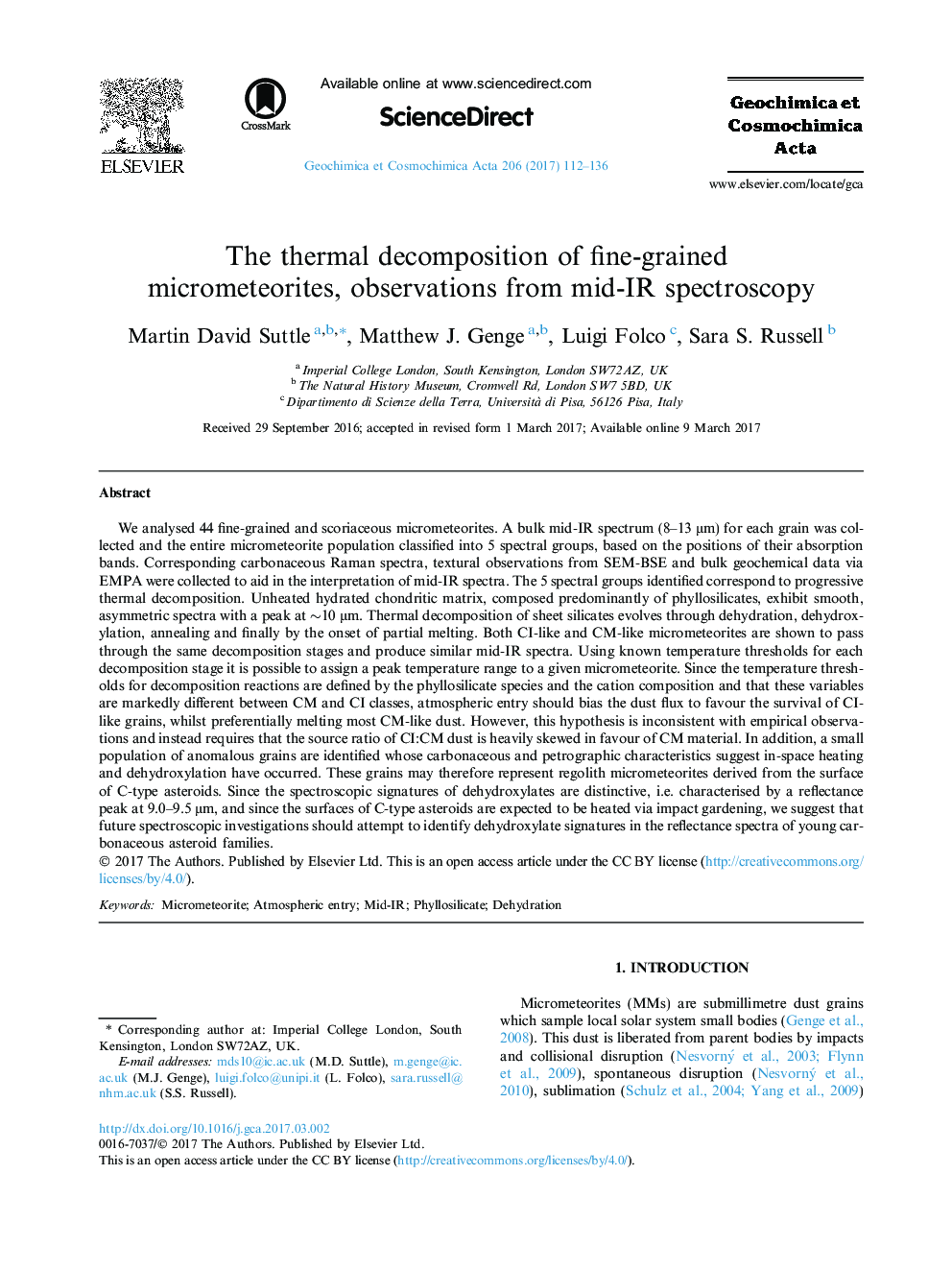| کد مقاله | کد نشریه | سال انتشار | مقاله انگلیسی | نسخه تمام متن |
|---|---|---|---|---|
| 5783415 | 1637951 | 2017 | 25 صفحه PDF | دانلود رایگان |
عنوان انگلیسی مقاله ISI
The thermal decomposition of fine-grained micrometeorites, observations from mid-IR spectroscopy
دانلود مقاله + سفارش ترجمه
دانلود مقاله ISI انگلیسی
رایگان برای ایرانیان
کلمات کلیدی
موضوعات مرتبط
مهندسی و علوم پایه
علوم زمین و سیارات
ژئوشیمی و پترولوژی
پیش نمایش صفحه اول مقاله

چکیده انگلیسی
We analysed 44 fine-grained and scoriaceous micrometeorites. A bulk mid-IR spectrum (8-13 μm) for each grain was collected and the entire micrometeorite population classified into 5 spectral groups, based on the positions of their absorption bands. Corresponding carbonaceous Raman spectra, textural observations from SEM-BSE and bulk geochemical data via EMPA were collected to aid in the interpretation of mid-IR spectra. The 5 spectral groups identified correspond to progressive thermal decomposition. Unheated hydrated chondritic matrix, composed predominantly of phyllosilicates, exhibit smooth, asymmetric spectra with a peak at â¼10 μm. Thermal decomposition of sheet silicates evolves through dehydration, dehydroxylation, annealing and finally by the onset of partial melting. Both CI-like and CM-like micrometeorites are shown to pass through the same decomposition stages and produce similar mid-IR spectra. Using known temperature thresholds for each decomposition stage it is possible to assign a peak temperature range to a given micrometeorite. Since the temperature thresholds for decomposition reactions are defined by the phyllosilicate species and the cation composition and that these variables are markedly different between CM and CI classes, atmospheric entry should bias the dust flux to favour the survival of CI-like grains, whilst preferentially melting most CM-like dust. However, this hypothesis is inconsistent with empirical observations and instead requires that the source ratio of CI:CM dust is heavily skewed in favour of CM material. In addition, a small population of anomalous grains are identified whose carbonaceous and petrographic characteristics suggest in-space heating and dehydroxylation have occurred. These grains may therefore represent regolith micrometeorites derived from the surface of C-type asteroids. Since the spectroscopic signatures of dehydroxylates are distinctive, i.e. characterised by a reflectance peak at 9.0-9.5 μm, and since the surfaces of C-type asteroids are expected to be heated via impact gardening, we suggest that future spectroscopic investigations should attempt to identify dehydroxylate signatures in the reflectance spectra of young carbonaceous asteroid families.
ناشر
Database: Elsevier - ScienceDirect (ساینس دایرکت)
Journal: Geochimica et Cosmochimica Acta - Volume 206, 1 June 2017, Pages 112-136
Journal: Geochimica et Cosmochimica Acta - Volume 206, 1 June 2017, Pages 112-136
نویسندگان
Martin David Suttle, Matthew J. Genge, Luigi Folco, Sara S. Russell,